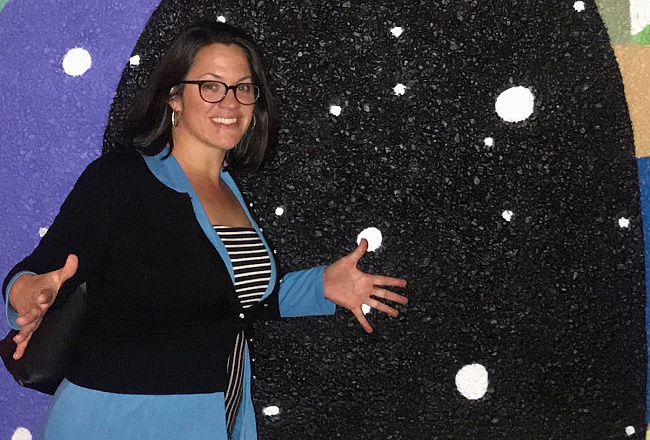Teaching Artist Takeaways: Kathleen Moye at North American Drama Therapy Association Annual Conference
Posted Wednesday December 05 2018 at 8:06 pm.
Used tags: conference, drama, teacher

On Oct. 26-29, I attended the North American Drama Therapy Association Annual Conference in Kansas City, Missouri. As conferences are built to do, it inspired me in several professional and personal directions. The hardest part was deciding what tool and trick I wanted to try first!
Drama therapy is an embodied approach to therapy that uses play, projection, narrative, and the power of an audience to help people. It's practiced in adaptable formats with patients of all ages and abilities in schools, recovery hospitals, trauma centers, community and group homes, private practice, and beyond.
As a VSA teaching artist, I was keenly interested in sessions that illuminated school-based or classroom-friendly approaches that could help students with physical, intellectual, and emotional needs. Among the many sessions I attended while there, I learned about:
● puppet work in El Salvador with women and teens about domestic violence and sex education,
● Sesame Street communities producing trauma-informed support materials and help children process big emotions,
● developing plays that educate audiences and demonstrate the strengths and capabilities of diverse and inclusive casts,
● using humor in creating therapeutic performances,
● new games for encouraging relationship development and conversation among participants,
● culturally inclusive and radically sensitive interactions in and out of therapeutic practice, and
● autobiographical play writing/processing.
Not only were the sessions inspiring, I left with a ton of games and tactics to try with individuals and small groups.
In my COOL Schools classroom, I've been focusing this year on how I can provide students with developmental, emotional, and behavioral disabilities more access to expression and participation. I also watch for ways to encourage students to notice and include one another. Here are three tips that I’m taking back to my classroom that you might want to try, too!
1. Instead of focusing on deficits or difficulties, focus on a student's strengths (asset-based teaching). One activity invited participants to write on one side of a piece of paper a label that someone else had given them or a struggle that they identify with (i.e. Hard of Hearing, Impulsive, Poor). On the other side of the paper, we wrote a strength or understanding that we saw in ourselves that may have come from our perceived "deficit" (i.e. Empathetic, Honest, Efficient). With each label we wrote a short improvised monologue and shared them with a partner. The deepening awareness that came from those short interactions helped participants connect with one another as well as see themselves from more than one perspective.
2. Free resources to help you do the work! Stepping in to a classroom for 45 minutes or an hour at a time can feel like exploring a strange new world. Chances are that the problem or challenge you end up facing isn't nearly as new as your awareness of it. I found great resources for emotional grounding and processing for young children over at Sesame Street Communities, that I was able to immediately put into place at one of my sites. The puppet workshop I attended demonstrated how to make puppets from toilet paper rolls. (See below.) Though not from this workshop, my other favorite classroom resource spot is Teachers Pay Teachers.


3. Culturally inclusive spaces do not happen in silence. It can be intimidating to step into a space and not fully understand the culture of the students around you. Their world, their abilities, their perspectives. What if we say something insensitive? What if someone assumes something about us that isn't true? What if someone tells us something we did was offensive? The "what ifs" don't have to be in charge. Avoiding the things that cause us discomfort won't make us better at handling it though. If you make a mistake and someone calls you on it, be grateful that someone chose to educate you. If you encounter a new cultural environment, start researching! If you meet someone different from you, see if you have something in common and make a connection. In the classroom, watch as much for the interactions you don't see as much as for the ones you do see (i.e. who is raising their hand or getting the attention, what images and visuals hang in the classroom vs. examples or imaginative creations generated from the students); get curious about those differences. Culturally inclusive to me means being open to correction, sensitive to changes in interactions, and proactive about researching new things outside of my own experience.
Now back to my COOL School lesson planning!
Kathleen Moye is a graduate student at Lesley University, studying Clinical Mental Health Counseling with a specialization in Drama Therapy. She holds a B.A. in Theatre from Florida Gulf Coast University, and is an accomplished voice-over actor. Her creative work also includes professional, educational, and applied theater productions. As a VSA teaching artist, she designs and and directs arts integration and theater programs for students with developmental, language-learning, and emotional needs. She also works with community groups, residential homes, and juvenile justice programs, with preschool- through high school-aged students.
TweetNo comments
